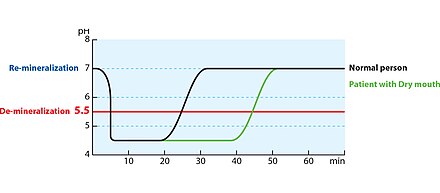Xerostomia
Xerostomia, commonly known as dry mouth, is the subjective sensation of oral dryness. This condition can be linked to changes in saliva composition, reduced salivary flow, or sometimes may have no identifiable cause.
It is prevalent among older adults and individuals on multiple medications. Conditions like dehydration, radiotherapy, chemotherapy, and various diseases can lead to reduced salivation or altered saliva consistency. Occasionally, xerostomia may have a psychogenic origin.

Signs and Symptoms
Xerostomia can manifest in several ways, including:
- Dental caries: Without saliva's buffering effects, tooth decay can progress aggressively.
- Acid erosion: Saliva helps prevent demineralisation of teeth.
- Oral candidiasis: Reduced saliva can lead to opportunistic infections with Candida species.
- Ascending sialadenitis: Infection of major salivary glands, often the parotid gland.
- Dysgeusia and dysosmia: Altered taste and smell sensations.
- Intraoral halitosis: Bad breath due to increased activity of bacteria on the tongue.
- Burning mouth syndrome: A burning or tingling sensation in the mouth.
- Dysphagia: Difficulty swallowing and chewing, especially dry foods.
- Other signs include dry mucosa, thick saliva, difficulty wearing dentures, and frequent thirst.

Causes
Physiological
Salivary flow naturally decreases during sleep, leading to dry mouth upon waking. Anxiety and dehydration can also reduce saliva production. Age-related changes in salivary glands might modestly reduce salivary output, but polypharmacy is a significant cause among older adults.
Drug-Induced Xerostomia
Over 400 medications are known to cause dry mouth, including psychoactive drugs, antihypertensives, bronchodilators, proton-pump inhibitors, antihistamines, diuretics, and antineoplastics. The likelihood of xerostomia increases with the total number of medications taken.
Sjögren's Syndrome
This autoimmune condition damages saliva-producing cells, leading to reduced secretions from glands throughout the body. Symptoms include fatigue, myalgia, and arthralgia.
Celiac Disease and Other Conditions
Celiac disease can present xerostomia as its sole symptom. Radiation therapy for head and neck cancers, sicca syndrome, mouth breathing, alcohol consumption, smoking, recreational drug use, hormonal disorders, nerve damage, hepatitis C, sarcoidosis, and HIV/AIDS can also cause xerostomia. COVID-19 is associated with persistent dry mouth symptoms.
Diagnostic Approach
Diagnosis is primarily based on clinical signs and symptoms. The Challacombe scale may classify dryness extent. Salivary flow rate can be measured using sialometry, and imaging techniques such as sialography, ultrasonography, and MRI may exclude other conditions. Blood tests, urinalysis, and minor salivary gland biopsy can help identify underlying causes. Xerophthalmia can be investigated using the Schirmer test and slit-lamp examination.
Treatment
Treating xerostomia is challenging and often unsatisfactory. The approach involves identifying and addressing correctable causes, preventing tooth decay, and managing symptoms using saliva substitutes and stimulants.
Saliva Substitutes
These include water, artificial salivas, and other substances like milk and vegetable oil. Products come in sprays, gels, oils, mouthwashes, and pastilles. Mucin-based products and Biotene oral Balance Gel & toothpaste have shown mixed results in trials.
Saliva Stimulants
These include organic acids, chewing gum, sugar-free mints, and parasympathomimetic drugs like pilocarpine and physostigmine. However, evidence for their effectiveness is limited. Studies suggest that chewing gum increases saliva production but does not significantly improve dry mouth symptoms.
Epidemiology
Xerostomia is common, affecting about 20% of the general population, with higher prevalences in females (up to 30%) and the elderly (up to 50%). Persistent dry mouth prevalence estimates range between 10% and 50%.
Self-assessment MCQs (single best answer)
What is xerostomia commonly known as?
Which of the following is NOT a common symptom of xerostomia?
What are some conditions that can lead to xerostomia?
Which autoimmune condition is associated with xerostomia due to damage to saliva-producing cells?
Which of the following diagnostic tests is used to measure salivary flow rate?
Which scale is used to classify the extent of dryness in xerostomia?
Which drug class is known to potentially cause dry mouth as a side effect?
Which of the following is NOT a method of treating xerostomia?
Which parasympathomimetic drug is used as a saliva stimulant?
What percentage of the general population is affected by xerostomia?
Dentaljuce
Dentaljuce provides Enhanced Continuing Professional Development (CPD) with GDC-approved Certificates for dental professionals worldwide.
Founded in 2009 by the award-winning Masters team from the School of Dentistry at the University of Birmingham, Dentaljuce has established itself as the leading platform for online CPD.
With over 100 high-quality online courses available for a single annual membership fee, Dentaljuce offers comprehensive e-learning designed for busy dental professionals.
The courses cover a complete range of topics, from clinical skills to patient communication, and are suitable for dentists, nurses, hygienists, therapists, students, and practice managers.
Dentaljuce features Dr. Aiden, a dentally trained AI-powered personal tutor available 24/7 to assist with queries and provide guidance through complex topics, enhancing the learning experience.
Check out our range of courses, or sign up now!


